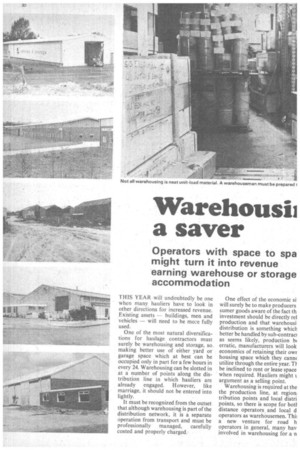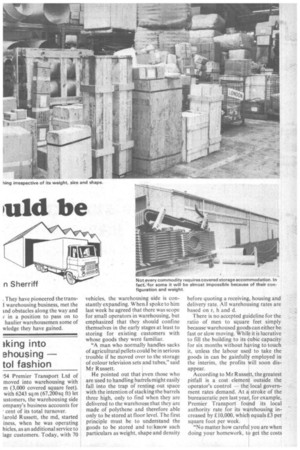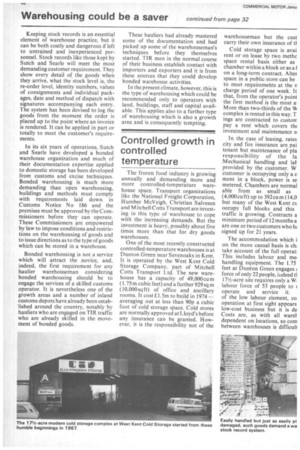Warehousii a saver
Page 32

Page 33

Page 34

Page 48

Page 49

If you've noticed an error in this article please click here to report it so we can fix it.
luld be
Operators with space to spa might turn it into revenue earning warehouse or storage accommodation
THIS YEAR will undoubtedly be one when many hauliers have to look in other directions for increased revenue. Existing assets — buildings, men and vehicles — will need to be moze fully used.
One of the most natural diversifications for haulage contractors must surely be warehousing and storage, so making better use of either yard or garage space which at best can be occupied only in part for a few hours in every 24. Warehousing can be slotted in at a number of points along the distribution line in which hauliers are already engaged. However, like marriage, it should not be entered into lightly.
It must be recognized from the outset that although warehousing is part of the distribution network, it is a separate operation from transport and must be professionally managed, carefully costed and properly charged. One effect of the economic si will surely be to make producers sumer goods aware of the fact th investment should be directly rel production and that warehousi distribution is something which better be handled by sub-contract as seems likely, production b( erratic, manufacturers will look economics of retaining their owr housing space which they cann( utilize through the entire year. TI be inclined to rent or lease space when required. Hauliers might t argument as a selling point.
Warehousing is required at the the production line, at region. tribution points and local distri points, so there is scope for botl distance operators and local d operators as warehousemen. Thi! a new venture for road h operators in general, many hay involved in warehousing for a n , They have pioneered the transI warehousing business, met the tnd obstacles along the way and r in a position to pass on to haulier warehousemen some of wledge they have gained.
iking into ehousing — tol fashion
54 Premier Transport Ltd of moved into warehousing with m (3,000 covered square feet). with 6243 sq m (67,200 sq ft) let ustomers, the warehousing side ompany's business accounts for • cent of its total turnover. larold Russett, the md, started mess, when he was operating hides, as an additional service to lage customers. Today, with 70 vehicles, the warehousing side is constantly expanding. When I spoke to him last week he agreed that there was scope for small operators in warehousing, but emphasized that they should confine themselves in the early stages at least to storing for existing customers with whose goods they were familiar.
"A man who normally handles sacks of agricultural pellets could be in serious trouble if he moved over to the storage of colour television sets and tubes," said Mr Russett He pointed out that even those who are used to handling barrels might easily fall into the trap of renting out space with the intention of stacking the barrels three high, only to find when they are delivered to the warehouse that they are made of polythene and therefore able only to be stored at floor level. The first principle must be to understand the goods to be stored and to know such particulars as weight, shape and density before quoting a receiving, housing and delivery rate. All warehousing rates are based on r, h and d.
There is no accepted guideline for the ratio of men to square feet simply because warehoused goods can either be. fast or slow moving. While it is lucrative to fill the building to its cubic capacity for six months without having to touch it, unless the labour used to take the goods in can be gainfully employed in the interim, the profits will soon disappear.
According to Mr Russett, the greatest pitfall is a cost element outside the operator's control the local government rates demand. At a stroke of the bureaucratic pen last year,for example, Premier Transport found its local authority rate for its warehousing increased by £10,000, which equals £3 per square foot per week.
"No matter how careful you are when doing your homework, to get the costs right, if you ignore the possibility of a heavy local authority rate increase, then you've got trouble," said Mr Russett. His advice is to keep the bargaining open-ended and if possible to confine contracts to three months' duration. Annual contracts should expire at the end of March s6 that the new charges take account of the current local authority rates.
The principle of charging warehousing space is similar to transport charging. There are standing charges which go on whether or not the building is being used for warehousing, such as the mortgage and the rates together with labour costs and, of course, there are running costs like electricity for lighting and heating and the operation of mechanical handling equipment. All of these costs must be brought together to find the true operating cost and when this has been ascertained, a percentage for profit must be added. I am told that 25 per cent is considered reasonable.
A final word on local authority rates. Because they are one of the largest cost factors and because they vary greatly between city and country areas. warehousing space separated by 100 yards but divided by a rateable area boundary will be let at vastly different rates. Premier Transport is based in a city location in Bristol and finds itself competing with other operators only a few miles away who are utilizing former aircraft hangars in the country. Mr Russett offers this advice. "Never quote a rate 'which won't cover your costs, no matter how strong the urge is to fill the empty buildings."
His advice to aspiring haulier warehousemen is not to be over dependent on one or two large customers. Through takeovers, rationalization and regionalization, their business can disappear overnight leaving the operator with empty, costly space.
Bonded stores — profitable but taxing
Warehousing must be regarded as an additional service to existing customers in the first instance, but for those who are prepared to work at it, it can become a lucrative full-time occupation. As recently as 1968, Sutch and Searle (Shipping) Ltd was operating a reasonably large collection and delivery fleet from London with warehousing as an intermediate service in which it stored goods before disratching them abroad. Today the road transport fleet is almost phased out whili the warehousing has become a principal part of the company's activities. Mr Ron Cundale now uses his years of road transport experience to service his other activities. "I know exactly the type and carrying capacity of the vehicles I require. I can specify in detail to the haulier, but more important I can give my customer a quotation taking into account the transport element without having to wait for the haulier to quote me," he said.
Mr Cundale's warehousing activities are more complex than most. In addition to the more commonplace bulk storage, Sutch and Searle handle literally anything from a needle to a ship's anchor. They store for the home market, but most of their goods eventually find themselves in the remotest corners of the world and on board ships on every sea.
The company's major customers are shipping lines whose demands require a 24-hour, seven-day week service and because of this, the smaller domestic market is able to enjoy the same facilities. This is one aspect of the Sutch and Searle business which the aspiring haulier warehouseman might like to copy. Mr Cundale stresses that the 24hT-a-day service is not a gimmick but is a genuine offer made, he said, to meet customer demands, giving them the facility to make full use of the daylight hours in which to deliver their goods. It also means that customers charge loaded vehicles into st load goods from storage wh deliveries are not possible.
Customers who themselves 24 hours a day like printing public.utilities, hospitals and c banks, are likely to look mon ably on a quotation from a 24 houseman even though the ct the service may be higher th those who limit their activities or 10hr day.
Small, domestic warehouserr do well to copy the Sutch an expedite service. Althou principle, which is really only chasing, has been practised in almost since the industrial re this method was new to me. Sutch and Searle customer p order on a supplier, they send the order to the warehousema that moment it is the warehoi responsibility to urge deliver house, document and re-dispau customer's instructions. This service relieves Sutch and customers of the tedium and tion of progress chasing and gi, more time to get on with till business, what ever that busine be. Keeping stock records is an essential element of warehouse practice, but it can be both costly and dangerous if left to untrained and inexperienced personnel. Stock records like those kept by Sutch and Searle will meet the most demanding customer requirement. They show every detail of the goods when they arrive, what the stock level is, the re-order level, identity numbers, values of consignments and individual packages, date and method of dispatch with signatures accompanying each entry. The system has been devised to log the goods from the moment the order is placed up to the point where an invoice is rendered. It can be applied in part or totally to meet the customer's requirements.
In its six years of operations, Sutch and Searle have developed a bonded warehouse organization and much of their documentation expertise applied to domestic storage has been developed from customs and excise techniques. Bonded warehousing is much more demanding than open warehousing, buildings and methods must comply with requirements laid down in Customs Notice No 186 and the premises must be approved by the Commissioners before they can operate. These Commissioners are empowered by law to impose conditions and restrictions on the warehousing of goods and to issue directions as to the type of goods which can be stored in a warehouse.
Bonded warehousing is not a service which will attract the ,novice, and, indeed, the first requirement for any haulier warehouseman considering bonded warehousing should be to engage the services of a skilled customs operator. It is nevertheless one of the growth areas and a number of inland customs depots have already been established around the country, notably by hauliers who are engaged on TIR traffic who are already skilled in the movement of bonded goods. These hauliers had already mastered some of the documentation and had picked up some of the warehouseman's techniques before they themselves started. TIR men in the normal course of their business establish contact with importers and exporters and it is from these sources that they could develop bonded warehouse activities.
In the present climate, however, this is the type of warehousing which could be recommended only to operators with land, buildings, staff and capital available. This applies also to a further type of warehousing which is also a growth area and is consequently tempting.
Controlled growth in controlled temperature
The frozen food industry is growing annually and demanding more and more controlled-temperature warehouse space. Transport organizations like the National Freight Corporation, Humber McVeigh, Christian Salvesen and Mitchell Cotts Transport are investing in this type of warehouse to cope with the increasing demands. But the investment is heavy, possibly about five times more than that for dry goods warehouses.
One of the most recently constructed controlled-temperature warehouses is at Dunton Green near Sevenoaks in Kent. It is operated by the West Kent Cold Storage Company, part of Mitchell Cotts Transport Ltd. The new warehouse has a capacity of 49,000 cu m (1.75 m cubic feet) and a further 929 sq m (10,000 sq ft) of office and ancillary rooms. It cost £1.5m to build in 1974 — averaging out at less than 90p a cubic foot of cold storage space. Cold stores are normally approved at Lloyd's before any insurance can be granted. However, it is the responsibility not of the warehouseman but the cust carry their own insurance of #1 Cold storage space is avai rent or on lease by two methc space rental basis either as chamber within a block or as at on a long-term contract. Alter space in a public store can be to meet requirements at the n charge period of one week. It that, from the operator's point the first method is the most al More than two-thirds of the IN complex is rented in this way. T ings are contracted to custom pay a rent which covers Oat investment and maintenance si In the case of leasing, rates city and fire insurance are pai tenant but maintenance of pla responsibility of the la Mechanical handling and tat provided by the customer. W customer is occupying only a c ment in a block, power is se metered. Chambers are normal able from as small as (4,000 cu ft) up to 392 cu m (14,0 but many of the West Kent cc occupy full blocks and this traffic is growing. Contracts a minimum period of 12 months a are one or two customers who ht signed up for 21 years.
The accommodation which i on the more casual basis is eh, take account of the full operati This includes labour and me, handling equipment. The 1.75 feet at Dunton Green engages force of only 22 people, indeed tl 171/2-acre site requires only a W, labour force of 53 people to I operate and service it. of the low labour element, co operation at first sight appears low-cost business but it is de Costs are, as with all ware dependent on locations, so corn between warehouses is difficult wever, factors which are to all and as costly to all.
stores must be manned by igineers for 24 hours a day to tat the refrigeration plant is trictioning. At West Kent there 00hp compressors serving the die cold store; eight are in wo on standby. There are four trucks in service during the working day and they are in the battery recharging bays Because maximum use must be the cubic capacity, there is a ital investment in caged pallets. 'stimated that a practical and e cold store should occupy not 5574 sq m (60,000 sq ft) with a height of 9. 14m (30ft) to the the building. It should run at Lures ranging from between —30°C ( 50°F to —22° F) and the iling and floor have to be insufest Kent has used laminated ene panels for the roof and walls c for the floors.
Inge of goods now being housed the country in controlled ture warehousing varies greatly ht, size and shape between Ts. Loose carcasses of beef are wkward to store economically nexample, cartons of tinned -2hocolate is very demanding in tment and is, of course, very /e to the pilferer. But here again, there appears to be little risk. Because of the small number of people required for any type of warehousing, pilferage is, I understand, not high. The staff can be carefully selected, and because only a few are involved, detection of theft is simple. 'In this connection, I understand that apart from customs goods, insurance coverage excluding fire should not exceed .E20 a ton.
Another option: letting space
For those who have space available but neither the know-how nor the inclination to master warehousing techniques, there is another option open. At Colsterworth in Lincolnshire, Humber McVeigh operates a one-off system. The company has rented space to a warehousing and distribution company which in turn sub-lets its space to customers so that while Humber McVeigh collects the rent, the physical part of the operation is the entire responsibility of its tenant. The tenant has the first option on supplying, collection and delivery vehicles but Humber McVeigh picks up any additional traffic.
Undoubtedly, many transport companies can benefit by involving themselves in warehousing, but, of course, the first basic requirement is available space, either open or covered. The question must be asked: "How much yard space or garage space is really required for accommodating vehicles?" Those who have both a garage and a yard, might think it prudent to park the vehicles in the open and turn the garage over to warehousing.
Alternatively, there are commodities like pipes and castings which will come to no harm if stored outside. If you have a basement area which you inherited when you took over the premises, an examination of it might produce revenue-earning space. Similarly, lofts and roof areas should not be ignored, but before this kind of space is turned over for load carrying a structural engineer or builder should be consulted. In any event, every possibility is well worth exploring.
























































































































